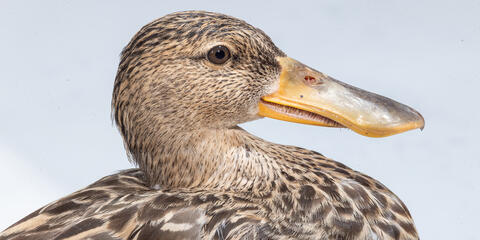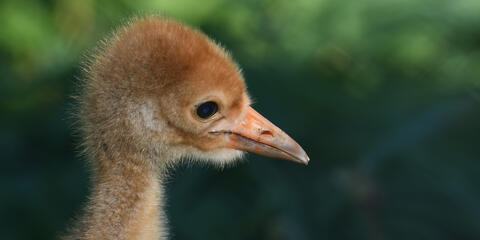Physical Description
Red pandas can be easily identified by their unique ruddy coat color, which acts like camouflage within the canopy of fir trees where branches are covered with clumps of reddish-brown moss and white lichens.
They have large, round heads and short snouts with big, pointed ears. Their faces are white with reddish-brown “tear” marks that extend from the eyes to the corner of the mouth. These markings could have evolved to help keep the sun out of their eyes. Their tails are marked with alternating red and buff rings.
Red pandas have a soft, dense woolly undercoat covered by long, coarse guard hairs. Long, bushy tails help these arboreal animals maintain balance and protect them from harsh cold and winds. Dense fur completely covers their feet which have five, widely separated toes and semi-retractable claws.
Red pandas scent-mark territories using anal glands and urine, as well as scent glands located between their footpads. These scent glands on the bottom of red pandas’ feet exude a colorless liquid that is odorless to humans. The red panda tests odors using the underside of its tongue, which has a cone-like structure for collecting liquid and bringing it close to a gland inside its mouth. It is the only carnivore with this adaptation.
Red pandas are skilled climbers, using trees for shelter, to escape predators and to sunbathe in the winter. Their ankles are extremely flexible, and the fibula and tibia are attached in such a way as to allow the fibula to rotate about its axis. These features make it possible for red pandas to adeptly climb headfirst down tree trunks.
In contrast with other carnivores their size, red pandas have extremely robust dentition. They also have a simple carnivore stomach, despite their predominantly leaf-based diet. Red pandas share the giant panda’s pseudo-thumb, a modified wrist bone used to grasp bamboo when feeding.
Red pandas are the only living member of the Ailuridae family, and their taxonomic position has long been a subject of scientific debate. They were first described as members of the raccoon family (Procyonidae) — a controversial classification — in 1825, because of ecological characteristics and morphological similarities of the head, dentition and ringed tail. Later, due to some agreements in DNA, they were assigned to the bear family (Ursidae).
Most recent genetic research, however, places red pandas in their own, independent family: Ailuridae. Molecular phylogenetic studies show that red pandas are an ancient species in the order Carnivora (superfamily Musteloidea) and are probably most closely related to the group that includes skunks, raccoons and weasels.
While originally thought to be two subspecies, new genetic studies suggest that there are two distinct species of red panda: Ailurus fulgens fulgens and Ailurus fulgens styani (also known as Ailurus fulgens refulgens). The latter tends to be larger and deeper red in color than the former.
Size
Adult red pandas typically weigh between 8 and 17 pounds (3.6 and 7.7 kilograms) and are 22 to 24.6 inches (56 to 62.5 centimeters) long, plus a tail of 14.6 to 18.6 inches (37 to 47.2 centimeters).
Native Habitat
Red pandas live in high-altitude, temperate forests with bamboo understories in the Himalayas and other high mountains. They range from northern Myanmar (Burma) to the west Sichuan and Yunnan Provinces of China. They are also found in suitable habitat in Nepal, India and Tibet. Ailurus fulgens fulgens lives predominantly in Nepal and can also be found in India and Bhutan. Ailurus fulgens styani (or Ailurus fulgens refulgens) is primarily found in China and Myanmar.
Lifespan
Red pandas may live as long as 23 years. They show symptoms of age at around 12 to 14 years old. While females do not breed after age 12, males continue to be reproductively capable.
Communication
Red pandas are generally quiet, but subtle vocalizations—such as squeals, twitters and huff-quacks—can be heard at close proximity. They may also hiss or grunt, and young cubs use a whistle, or high-pitched bleat, to signal distress. Red pandas will climb trees and rocks to escape predators, such as leopards and jackals.
Food/Eating Habits
Bamboo constitutes about 95% of the red panda's diet. Unlike giant pandas that feed on nearly every above-ground portion of bamboo (including the culm, or woody stem), red pandas feed selectively on the most nutritious leaf tips and, when available, tender shoots.
Like giant pandas, red pandas grasp plant stems using their forepaws and shear selected leaves off with their mouths. Because red pandas are obligate bamboo eaters, they are on a tight energy budget for much of the year. They may also forage for roots, succulent grasses, fruits, insects and grubs, and are known to occasionally kill and eat birds and small mammals.
At the Smithsonian's National Zoo, red pandas eat bamboo, bamboo shoots (when in season) and leafeater biscuits. They are receive enrichment treats, such as apples, grapes, bananas, blueberries and other produce.
Sleep Habits
In human care, red pandas can be active at any time of day but are primarily crepuscular, or most active at dawn and dusk. On average, they spend about 45 percent of the day awake and tend to be more active in cooler weather, especially during the winter mating season.
In significantly cold temperatures, red pandas can become dormant, lowering their metabolic rate and raising it every few hours as they wake up to look for food.
This adaptation allows red pandas to spend nearly as little energy as sloths, which is very beneficial considering the low nutrition content of their diet. They also exhibit temperature-regulating behaviors, such as curling into a tight ball to conserve body heat and energy expenditure in the cold. Conversely, when temperatures are warm, red pandas stretch out on branches and pant to lower their body temperature.
Social Structure
Red pandas are solitary except during the breeding season. In human care, most breeding pairs live together year-round. In the wild, the home range of one animal is about 1 square mile.
Reproduction and Development
In the Northern Hemisphere, red pandas breed from January through March. In the Southern Hemisphere, breeding season extends from June through August. The rapid change in photoperiod, or day length, after the winter solstice initiates this breeding season.
Mating occurs on the ground, and gestation appears to include a period of delayed implantation, which may be as short as 93 days or as long as 156 days. Reproduction expends a great deal of energy, so it is believed that a long gestation period may be the result of a slow metabolic rate. Late spring births also coincide with the emergence of the most tender and digestible bamboo shoots and leaves.
Females create a nest in tree holes, hollow stumps, tree roots or bamboo thickets and line the nest with moss, leaves and other soft plant material. Litters typically consist of two cubs born between May and July in the Northern Hemisphere.
Red pandas are born completely covered in fur to protect them from the cold environment. Newborns of the species Ailurus fulgens fulgens weigh 3-4 ounces (about 90-110 grams). The offspring stay with the mother for about one year, which is about when they are full-grown. Red pandas reach sexual maturity at around 18 months of age.
Conservation Efforts
Red pandas are endangered and are legally protected in India, Bhutan, China, Nepal and Myanmar. Their primary threats are habitat loss and degradation, human interference and poaching.
Researchers believe that the total population of red pandas has declined by 40 percent over the past two decades. It is probable that this decline will continue in the coming years. Red pandas are present in some protected areas throughout their range, including parks in Myanmar, Bhutan, India, Nepal and China. Despite regulations, livestock grazing, hunting and logging still occur throughout many of these protected areas.
Habitat loss is primarily attributed to logging, grazing livestock, demand for firewood, human encroachment and farming. The decrease in suitable habitat for red pandas has coincided with the increase in human populations throughout Asia; with human encroachment comes livestock, agriculture and dogs, all of which produce different threats to this species.
Herds of livestock can compete with red pandas for available bamboo leaves and degrade their habitat. Clearing land to make way for crops reduces available food and shelter. And domestic dogs can hunt or transmit disease, such as canine distemper, to red pandas. Additionally, fragmentation resulting from habitat loss has resulted in inbreeding, as red panda populations become increasingly isolated.
The illegal pet trade has reportedly been on the rise throughout Asia. However, poaching and the illegal trade of red panda pelts, meat and other products has decreased.
These threats to red pandas are compounded by climate change and natural disasters, inadequate enforcement of laws and regulations, and limited investment in red panda conservation by local governments. Red pandas have bred with some reliability in zoos throughout North America, Europe and Asia. As they decline in the wild, growing and maintaining self-sustaining populations in zoos is a high priority as a hedge against extinction and to learn more about species biology.
Part of the difficulty in conserving red pandas relates to their unique habitat. These animals require a specific set of circumstances to optimize survival, including proximity to water sources, appropriate forest cover and altitude, and sufficient bamboo. As human encroachment continues to grow, these ideal habitats become increasingly more difficult to find. Bamboo grows unreliably in degraded habitats, which adds additional stress to the situation.
The Smithsonian's National Zoo and Conservation Biology Institute has been at the forefront of red panda conservation, with more than 100 surviving cubs born since 1962.
The International Union for Conservation of Nature has prioritized four major categories of action for conserving red pandas: protect against habitat loss, reduce habitat degradation, reduce deaths of red pandas (through poaching and removing man-made threats) and improve awareness.
Help this Species
- Reduce, reuse and recycle — in that order! Cut back on single-use goods, and find creative ways to reuse products at the end of their life cycle. Choose recycling over trash when possible.
- Practice ecotourism by being an advocate for the environment when you’re on vacation. During your travels, support, visit or volunteer with organizations that protect wildlife. Shop smart too! Avoid buying products made from animals, which could support poaching and the illegal wildlife trade.
- Support organizations like the Smithsonian’s National Zoo and Conservation Biology Institute that research better ways to protect and care for this animal and other endangered species. Consider donating your time, money or goods.
- Are you a student? Did you love what you learned about this animal? Make it the topic of your next school project, or start a conservation club at your school. You'll learn even more and share the importance of saving species with classmates and teachers, too.
- Less is more. Cut down on the demand for resources by consuming less. Buy only what you need, and look for pre-owned or repurposed items before purchasing something brand new.
Meet the Animals
Two female red pandas, named Asa and Chris Anne, live on Asia Trail. Asa was born at Smithsonian’s Conservation Biology Institute in 2014. She is the larger of the two red pandas, with dark red tear-marks on her face and uniform red fur along her sides. Chris Anne is much smaller than Asa, with pale orange facial markings and blonde fur on her hips and tail.
Animal News

Historic Hatching: Northern Shoveler Ducklings


